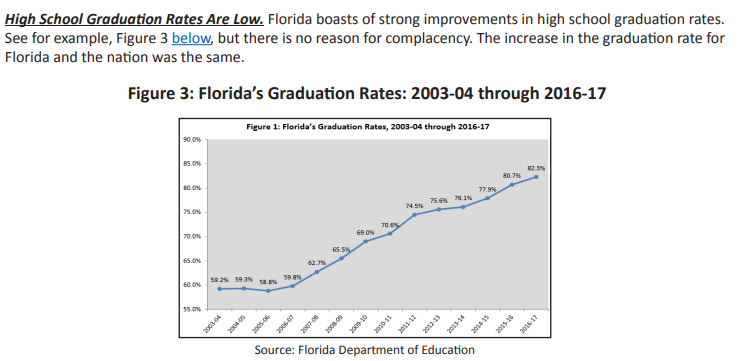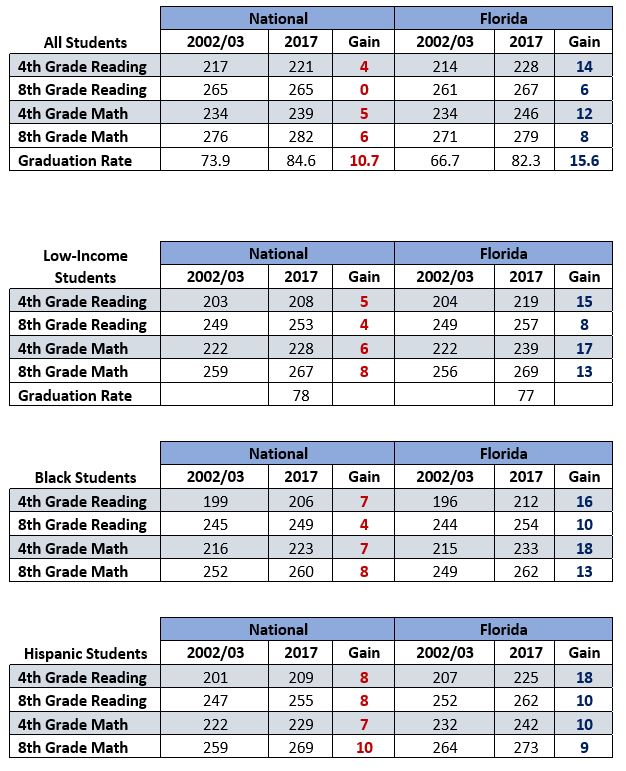The Florida Education Association and allies are gathering at an education summit Saturday in Orlando to discuss “the legislature’s attack on public schools.”
“Our neighborhood schools are under attack – there’s no other way to describe it,” FEA president Fedrick Ingram said in a news release.
But the only attack on Florida’s public schools is from the FEA and its friends, who consistently refuse to acknowledge the impressive gains made in public education over the last 20 years.
In an effort to increase teacher pay and per-pupil spending, these critics assail school choice programs, testing and more, while claiming – almost always without any supporting evidence – that Florida’s K-12 system is subpar.
When provided evidence to the contrary, critics compare Florida, which has a majority-minority student population, with states that are significantly whiter and wealthier.
Examples of denial abound, but few are worse than the laborious 66-page “research” on Florida’s A+ plan by League of Women Voters Education Chair and University of Florida professor Sue Legg.
Her report, “Twenty Years Later: The Jeb Bush A+ Plan Fails Florida’s Students,“ generously redefines words like “fail” when describing achievement gains over the last two decades. Evidence within the report often contradicts its opening claim that “Florida’s student achievement is no better and no worse than in 2002.”
Charts like this, from Page 15, show tremendous gains for black and white students over time, but Legg moves the goalposts from achievement growth to whether or not Florida retains its rank on later tests relative to other states. In other cases, she shifts to whether Florida bests the national average, which reflects states that are wealthier and whiter than Florida.
Florida did a phenomenal job improving fourth-grade reading scores across the board. Black students in Florida improved a whopping 26 points, double the national average. The achievement gap between white and black students even shrunk slightly.
Legg attempts to rain on the parade by incorrectly claiming Florida’s eighth-grade scores “remained substantially lower than fourth grade.” Florida’s ranking on eighth-grade achievement was lower than its fourth-grade ranking, but its student scores were not.
Florida did improve eighth-grade reading, but the improvement was not as dramatic as the fourth-grade scores. Scores went from 255 in 1998 to 267 in 2017, an improvement of “just” 12 points. But that was double the national average.
Legg can’t even celebrate Florida’s major improvement in graduation rates. Take Figure 3 from Page 16 of her report. She notes Florida’s dramatic improvement in graduation rates using an older figure (latest figure here), then claims (without evidence) that Florida’s graduation rate improvement was the same as the rest of the U.S. It was not.
According to U.S. Department of Education statistics (here and here), in 1999 the average graduation rate for all states was 71.7 percent. By 2016-17, the graduation rate had increased to 85 percent, an improvement of 13.3 points. Florida, by comparison, increased from 61 percent in 1999 to 82 percent by 2016-17, an improvement of 21 points, well above the national gain.
Here Legg not only misstates the facts, but she changes the focus from whether improvement occurred to whether a lower-income, majority-minority state can best the national average. It’s worth noting that Florida’s graduation rates improved 4 points to 86 percent in 2017-18.
Florida’s achievement results are better today than in 1999 when the A+ plan was enacted. Results are also better today than in 2002. Legg’s claim that “Florida’s student achievement is no better and no worse than in 2002” is flat wrong from every angle.
Florida has across-the-board achievement gains in reading and math, almost always besting the national average, sometimes by significant margins.
Legg offers her report as a means to “understand how Florida has reached this abyss.”
By “abyss,” does she mean a deep or seemingly bottomless chasm of improvement?
Having predicted catastrophic results for public education for years as school choice expanded, many critics stubbornly refuse to acknowledge that things got better – much better. More can, and should, be done to improve educational outcomes in the Sunshine State, but we all need to give our education system a big high-five for the monumental effort so far.
There is a right way to call for more spending and higher teacher pay. It starts with applauding the results and saying, “look how we’ve accomplished so much with so little,” and finishes by asking others to “imagine what we could do if we had more.”
Just don’t expect to see such candor at the teacher union summit Saturday.






[…] could have checked here, and here. Or […]
[…] the Florida Department of Education and other proponents of school choice celebrate successes using (guess what?) standardized test scores (NAEP, the […]